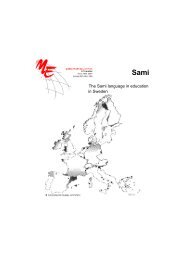Multilingual Early Language Transmission (MELT) - Mercator ...
Multilingual Early Language Transmission (MELT) - Mercator ...
Multilingual Early Language Transmission (MELT) - Mercator ...
You also want an ePaper? Increase the reach of your titles
YUMPU automatically turns print PDFs into web optimized ePapers that Google loves.
the best one to raise a child multilingual? And what are the best strategies to continue to be<br />
a multilingual person? What are the conditions to become a permanent multilingual adult?<br />
Grosjean (2010) presents five strategies that parents can follow to promote bilingual<br />
children:<br />
one parent - one language strategy;<br />
home - outside the home strategy;<br />
one - language-first strategy;<br />
language - time strategy;<br />
free - alternation strategy.<br />
The best known (and also commonly used in pre-schools) is the first strategy "one parent-<br />
one language." Each of the parents speaks a different language to the child (for example, the<br />
father Dutch and the mother Frisian). Based on this strategy, common practice in day-care<br />
centres includes that the practitioners accommodate which language they will speak to the<br />
children (for example, one caretaker speaks Breton and the other one speaks French). The<br />
child is able to discern the two languages and to make the necessary separations faster and<br />
more efficiently. Grosjean (2010) thinks it’s a fine strategy in the very first months of<br />
language development, when children are primarily with their parents. But as soon as the<br />
children go out into the outside world this strategy can become a problem. The minority<br />
language will eventually have less and less input, children hear and use the majority<br />
language much more. Children don’t want to be an outsider, when they speak the minority<br />
language in a majority language environment.<br />
The second strategy is also well known, the “home-outside the home” strategy. The child<br />
speaks one language (the minority language) at home and a majority language outside. The<br />
child learns and practices the community language at school while the parent's native<br />
language is learnt at home. The majority language will take care of itself outside the home<br />
through day care, school, friends, other family members, peers and watching television. In<br />
mixed families however, one of the inconveniences of this strategy, according Grosjean<br />
(2011), is the fact that one of the parents will probably have to speak his or her second (or<br />
third) language to the child so that everyone speaks just one language in the home.<br />
The third strategy Grosjean (2010) describes is the “one-language- first” strategy. Usually the<br />
first language is the minority language. Parents make sure that every contact the child has,<br />
with other caretakers, family members, playmates, television, and so on, has to take place in<br />
the minority language. Once that language is well accomplished parents allow the other<br />
(usually the majority) language to be acquired. The acquisition of the majority language, the<br />
community language, happens usually very fast. This strategy is successful when the family is<br />
surrounded by a well-organized and quite large minority language community so that the<br />
child is given all the language input he or she needs.<br />
Some immersion methods shows some overlap with the “one-language- first” strategy.<br />
Immersion programs may be categorized according to age and extent of immersion.<br />
Cummins (2000) describes different immersion programs used for instruction by classroom-<br />
teachers.<br />
64



